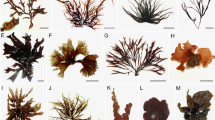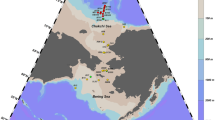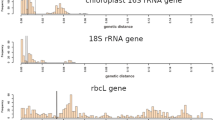Abstract
We examined phylogenetic relationships among three Bathymodiolus species in Japanese waters and Bathymodiolus spp. from the Manus Basin by two different approaches. Two-dimensional gel electrophoresis allowed us to compare 263–407 (average=318) proteins, giving comprehensive information on genetic distances among the species. The neighbor-joining tree presented two clusters: (1) B. japonicus and B. platifrons and (2) B. septemdierum and B. sp. Members of the first cluster contain methanotrophic endosymbiotic bacteria and members of the second cluster contain thioautotrophic endosymbionts. DNA sequencing of a fragment (415 bp) of mitochondrial cytochrome c oxidase subunit I (COI) provided a neighbor-joining tree with the same topology as that derived from protein analysis. Inspection of intraspecific variation in COI in B. japonicus and B. platifrons revealed no genetic differentiation between mussel populations of either species from cold-water seeps versus hydrothermal vents, suggesting high adaptability of these Bathymodiolus species to deep-sea chemosynthetic environments. Our results indicated genetic exchanges between mussels from distant localities, suggesting that a limited dispersal capability of the larvae is not the likely factor leading to speciation events in these Bathymodiolus species.








Similar content being viewed by others
References
Aquadro CF, Avise JC (1981) Genetic divergence between rodent species assessed by using two-dimensional gel electrophoresis. Proc Natl Acad Sci USA 78:3784–3788
Black MB, Halanych KM, Maas WR, Hoeh WR, Hashimoto J, Desbruyères D, Lutz RA, Vrijenhoek RC (1997) Molecular systematics of vestimentiferan tube worms from hydrothermal vents and cold-water seeps. Mar Biol 130:141–149
Cary SC, Giovannoni SJ (1993) Transovarial inheritance of endosymbiotic bacteria in clams inhabiting deep-sea hydrothermal vents and cold seeps. Proc Natl Acad Sci USA 90:5695–5699
Cosel R von, Olu K (1998) Gigantism in Mytilidae. A new Bathymodiolus from cold seep areas on the Barbados accretionary Prism. CR Acad Sci Paris Sci Vie 321:655–663
Cosel R von, Métivier B, Hashimoto J (1994) Three new species of Bathymodiolus (Bivalvia: Mytilidae) from hydrothermal vents in the Lau Basin and the North Fiji Basin, western Pacific, and the Snake Pit area, Mid-Atlantic Ridge. Veliger 37:374–392
Cosel R von, Comtet T, Krylova EM (1999) Bathymodiolus (Bivalvia: Mytilidae) from hydrothermal vents on the Azores Triple Junction and the Logatchev hydrothermal field, Mid-Atlantic Ridge. Veliger 42:218–248
Craddock C, Hoeh WR, Gustafson RG, Lutz RA, Hashimoto J, Vrijenhoek RJ (1995a) Evolutionary relationships among deep-sea mytilids (Bivalvia: Mytilidae) from hydrothermal vents and cold-water methane/sulfide seeps. Mar Biol 121:477–485
Craddock C, Hoeh WR, Lutz RA, Vrijenhoek RJ (1995b) Extensive gene flow among mytilid (Bathymodiolus thermophilus) populations from hydrothermal vents of the eastern Pacific. Mar Biol 124:137–146
Distel DL, Felbeck H, Cavanaugh CM (1994) Evidence for phylogenetic congruence among sulfur-oxidizing chemoautotrophic bacterial endosymbionts and their bivalve hosts. J Mol Evol 38:533–542
Distel DL, Lee HK-W, Cavanaugh CM (1995) Intracellular coexistence of methano- and thioautotrophic bacteria in a hydrothermal vent mussel. Proc Natl Acad Sci USA 92:9598–9602
Distel DL, Baco AR, Chuang E, Morrill W, Cavanaugh CM, Smith CR (2000) Do mussels take wooden steps to deep-sea vents? Nature 403:725–726
Felsenstein J (1994) PHYLIP: phylogeny inference package, version 3.56c. University of Washington, Seattle
Folmer O, Black M, Hoeh W, Lutz R, Vrijenhoek R (1994) DNA primers for amplification of mitochondrial cytochrome c oxidase subunit I from diverse metazoan invertebrates. Mol Mar Biol Biotechnol 3:294–299
France SC, Kocher TD (1996) Geographic and bathymetric patterns of mitochondrial 16S rRNA sequence divergence among deep-sea amphipods, Eurythenes gryllus. Mar Biol 126:633–643
Fujikura K, Kojima S, Fujiwara Y, Hashimoto J, Okutani T (2000) New distribution records of vesicomyid bivalves from deep-sea chemosynthesis-based communities in Japanese waters. Venus Jpn J Malacol 59:103-121
Fujiwara Y, Takai K, Uematsu K, Tsuchida S, Hunt JC, Hashimoto J (2000) Phylogenetic characterization of endosymbionts in three hydrothermal vent mussels: influence on host distributions. Mar Ecol Prog Ser 208:147–155
Goffredi SK, Hurtado LA, Hallam S, Vrijenhoek RC (2003) Evolutionary relationships of deep-sea vent and cold seep clams (Mollusca: Vesicomyidae) of the “pacifica/lepta” species complex. Mar Biol 142:311–320
Grassle JP (1985) Genetic differentiation in populations of hydrothermal vent mussels (Bathymodiolus thermophilus) from the Galapagos Rift and 13°N on the East Pacific Rise. Biol Soc Wash Bull 6:429–442
Gustafson RG, Turner RD, Lutz RA, Vrijenhoek RC (1998) A new genus and five new species of mussels (Bivalvia: Mytilidae) from deep-sea sulfide/hydrocarbon seeps in the Gulf of Mexico. Malacologia 40:63–112
Hashimoto J (2001) A new species of Bathymodiolus (Bivalvia: Mytilidae) from hydrothermal vent communities in the Indian Ocean. Venus Jpn J Malacol 60:141–149
Hashimoto J, Okutani T (1994) Four new mytilid mussels associated with deep sea chemosynthetic communities around Japan. Venus Jpn J Malacol 53:61–83
Hirabayashi T (1981) Two-dimensional gel electrophoresis of chicken skeletal muscle proteins with agarose gels in the first dimension. Anal Biochem 117:443–451
Hoeh WR, Black MB, Gustafson R, Bogan AE, Lutz RA, Vrijenhoek RC (1998) Testing alternative hypotheses of Neotrigonia (Bivalvia: Trigonioidea) phylogenetic relationships using cytochrome c oxidase subunit I DNA sequences. Malacologia 40:267–278
Jollivet D, Desbruyères D, Kadrat C, Laubier L (1995) Evidence for differences in the allozyme thermostability of deep-sea hydrothermal vent polychaetes (Alvinellidae): a possible selection by habitat. Mar Ecol Prog Ser 123:125–136
Kenk VC, Wilson BR (1985) A new mussel (Bivalvia, Mytilidae) from hydrothermal vents in the Galapagos Rift Zone. Malacologia 26:253–271
Kimura M (1980) A simple method for estimating evolutionary rate of base substitutions through comparative studies of nucleotide. J Mol Evol 16:111–120
Kojima S (2002) Deep-sea chemoautosynthesis-based communities in the northwestern Pacific. J Oceanogr 58:343–363
Kojima S, Segawa R, Kobayashi T, Hashimoto T, Fujikura K, Hashimoto J, Ohta S (1995) Phylogenetic relationships among species of Calyptogena (Bivalvia: Vesicomyidae) collected around Japan revealed by nucleotide sequences of mitochondrial genes. Mar Biol 122:401–407
Kojima S, Segawa R, Fujiwara Y, Hashimoto J, Ohta S (2000) Genetic differentiation of populations of a hydrothermal vent–endemic gastropod, Ifremeria nautilei, between the North Fiji Basin and the Manus Basin revealed by nucleotide sequences of mitochondrial DNA. Zool Sci (Tokyo) 17:1167–1174
Kojima S, Ohta S, Yamamoto T, Miura T, Fujiwara Y, Hashimoto J (2001a) Molecular taxonomy of vestimentiferans of the western Pacific and their phylogenetic relationships to species of the eastern Pacific. I. Family Lamellibrachiidae. Mar Biol 139:211–219
Kojima S, Segawa R, Fujiwara Y, Fujikura K, Ohta S, Hashimoto J (2001b) Phylogeny of hydrothermal-vent-endemic gastropods Alviniconcha spp. from the western Pacific revealed by mitochondrial DNA sequences. Biol Bull (Woods Hole) 200:298–304
Lutz RA, Bouchet P, Jablonski D, Turner RD, Warén A (1986) Larval ecology of mollusks at deep-sea hydrothermal vents. Am Malacol Bull 4:49–54
Maas PA, O’Mullan GD, Lutz RA, Vrijenhoek RC (1999) Genetic and morphometric characterization of mussels (Bivalvia: Mytilidae) from Mid-Atlantic hydrothermal vents. Biol Bull (Woods Hole) 196:265–272
Miyazaki J-I, Sekiguchi K, Hirabayashi T (1987) Application of an improved method of two-dimensional electrophoresis to the systematic study of horseshoe crabs. Biol Bull (Woods Hole) 172:212–224
Miyazaki J-I, Ueshima R, Hirabayashi T (1988) Application of a two-dimensional electrophoresis method to the systematic study of land snails of subgenus Luchuphaedusa from southwestern Japan islands. Biol Bull (Woods Hole) 175:372–377
Miyazaki J-I, Hirabayashi T, Hosoya K, Iwami T (1998) A study of the systematics of cyprinid fishes by two-dimensional gel electrophoresis. Environ Biol Fishes 52:173–179
Moraga D, Jollivet D, Denis F (1994) Genetic differentiation across the western Pacific populations of the hydrothermal vent bivalve Bathymodiolus spp. and the eastern Pacific (13°N) population of Bathymodiolus thermophilus. Deep-Sea Res 41:1551–1567
Oh-ishi M, Hirabayashi T (1988) Micro-two-dimensional gel electrophoresis with agarose gel in the first dimension. Phys-Chem Biol 32:1–8
Olu K, Duperret A, Sibuet M, Foucher J-P, Fiala-Médioni A (1996) Structure and distribution of cold seep communities along the Peruvian active margin: relationship to geological and fluid patterns. Mar Ecol Prog Ser 132:109–125
Peek AS, Gustafson RG, Lutz RA, Vrijenhoek RC (1997) Evolutionary relationships of deep-sea hydrothermal vent and cold-water seep clams (Bivalvia: Vesicomyidae): results from mitochondrial cytochrome oxidase subunit I. Mar Biol 130:151–161
Peek AS, Gaut BS, Feldman RA, Barry JP, Kochevar RE, Lutz RA, Vrijenhoek RC (2000) Neutral and nonneutral mitochondrial genetic variation in deep-sea clams from the family Vesicomyidae. J Mol Evol 50:141–153
Saitou N, Nei M (1987) The neighbour-joining method: a new method for reconstructing phylogenetic trees. Mol Biol Evol 4:406–425
Shank TM, Black MB, Halanych KM, Lutz RA, Vrijenhoek RC (1999) Miocene radiation of deep-sea hydrothermal vent shrimp (Caridea: Bresiliidae): evidence from mitochondrial cytochrome oxidase subunit I. Mol Phylogenet Evol 13:244–254
Sneath PHA, Sokal RR (1973) Numerical taxonomy. Freeman, San Francisco
Swofford DL (1993) PAUP: phylogenetic analysis using parsimony, version 3.1.1. Illinois Nat Hist Sur, Champaign
Tokita M, Ishii S, Iwami T, Miyazaki J-I (2002) Phylogenetic analysis of Antarctic notothenioid fishes based on two-dimensional gel electrophoresis. Polar Biol 25:163–168
Tsubokawa R, Miyazaki J-I (1993) Application of a two-dimensional electrophoresis method to the systematic study of Notaspidea (Mollusca: Opisthobranchia). Veliger 36:209–214
Vrijenhoek RC (1997) Gene flow and genetic diversity in naturally fragmented metapopulations of deep-sea hydrothermal vent animals. J Hered 88:285–293
Won Y, Young CR, Lutz RA, Vrijenhoek RC (2003a) Dispersal barriers and isolation among deep-sea mussel populations (Mytilidae: Bathymodiolus) from eastern Pacific hydrothermal vents. Mol Ecol 12:169–184
Won Y, Hallam SJ, O’Mullan GD, Pan IL, Buck KR, Vrijenhoek RC (2003b) Environmental acquisition of thiotrophic endosymbionts by deep-sea species of the genus Bathymodiolus. Appl Environ Microbiol (in press)
Acknowledgements
We thank the operation team of the submersible “Shinkai 2000” and the officers and crew of the support vessel “Natsushima” for their help in collecting samples. This study is supported in part by a grant from the Research Institute of Marine Invertebrates and a grant from the Ministry of Education, Culture, Sports, Science and Technology of Japan (no. 12NP0201).
Author information
Authors and Affiliations
Corresponding author
Additional information
Communicated by T. Ikeda, Hakodate
Rights and permissions
About this article
Cite this article
Miyazaki, JI., Shintaku, M., Kyuno, A. et al. Phylogenetic relationships of deep-sea mussels of the genus Bathymodiolus (Bivalvia: Mytilidae). Marine Biology 144, 527–535 (2004). https://doi.org/10.1007/s00227-003-1208-3
Received:
Accepted:
Published:
Issue Date:
DOI: https://doi.org/10.1007/s00227-003-1208-3




